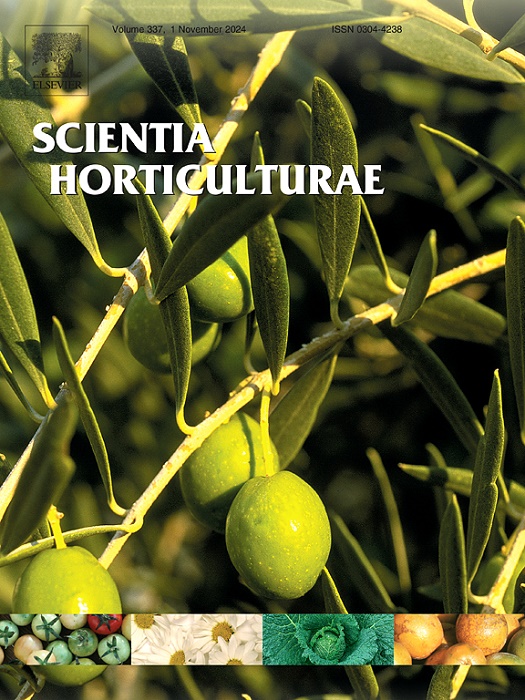与瑞士甜菜(Beta vulgaris ssp.
IF 3.9
2区 农林科学
Q1 HORTICULTURE
引用次数: 0
摘要
由于其口感细嫩,富含多种有益物质,微型蔬菜的市场正在迅速增长。用于生产微菜的植物种类繁多,而且仍在不断扩大。Atriplex hortensis var. rubra L.(红萝藦;RO)的特点是维生素 C 含量高,叶片呈红紫色,可以替代其他红叶植物用于微绿菜种植。通过生物强化人体必需的微量营养素,如硒(Se)和锌(Zn),可以进一步提高微型绿菜的营养保健功能。我们研究的目的是,与瑞士芥蓝菜(Beta vulgaris ssp.微绿色植物生长在椰糠中,播种时用含有不同浓度硒酸钠(Na2SeO4;0、1、3 和 5 毫克 Se L-1)或硫酸锌(ZnSO4;0、2、6 和 10 毫克 Zn L-1)的水进行灌溉。研究了在播种时向基质中添加不同浓度的硒(0、1、3 和 5 毫克/升-1 硒)或锌(0、2、6 和 10 毫克/升-1 锌)溶液对这两种微绿色植物的生长和营养特性的影响,以及它们对人类每日所需硒和锌的潜在贡献。RO的鲜重、色素浓度、抗氧化化合物(尤其是抗坏血酸)和硝酸盐以及微蔬果的总抗氧化能力都明显高于SC。用硒或锌处理对南华和轮作微绿叶的产量和质量没有明显影响,但却分别增加了微绿叶的硒浓度(从 0.57 到 6.96 毫克/千克-1 水分)或锌浓度(从 4.46 到 12.55 毫克/千克-1 水分)。硒的生物强化比锌更有效。生物强化 5 毫克升/升硒的 10 克微绿叶蔬菜的食用剂量可满足人类对该元素的日常需求。为了从含 10 毫克锌(升/升)的 SC 和 RO 微绿叶中获得大量(15%)的锌,食用剂量至少应为 100 克。本文章由计算机程序翻译,如有差异,请以英文原文为准。
Exploiting the potential of red orache (Atriplex hortensis var. rubra L.) for the production of microgreens biofortified with selenium or zinc in comparison with Swiss chard (Beta vulgaris ssp. vulgaris var. cicla)
The market of microgreens is rapidly growing due to their tenderness and concentrations of many beneficial substances. The range of plant species grown for microgreens production is large and still expanding. Atriplex hortensis var. rubra L. (red orache; RO) is characterised by high vitamin C content and red-purple leaves, and could replace other red-leaved plants in microgreen boxes. The nutraceutical profile of microgreens could be further enhanced by biofortification with essential micronutrients for humans, such as selenium (Se) and zinc (Zn). The aim of our study was to explore the potential of RO for the production of microgreens biofortified with selenium (Se) or zinc (Zn) in comparison with Swiss chard (Beta vulgaris ssp. vulgaris var. cicla; SC), which is a more commonly consumed microgreen. Microgreens were grown in coconut coir irrigated at sowing with water containing different concentrations of sodium selenate (Na2SeO4; 0, 1, 3, and 5 mg Se L-1) or zinc sulphate (ZnSO4; 0, 2, 6, and 10 mg Zn L-1). The impact of adding a solution containing different concentrations of Se (0, 1, 3, and 5 mg L-1 Se) or Zn (0, 2, 6, and 10 mg L-1 Zn) to the substrate, at the time of sowing, on the growth and nutraceutical characteristics of the microgreens of both species was investigated together with their potential contribution to the daily requirements of Se and Zn for humans. The fresh weight and concentration of pigments, antioxidant compounds, especially ascorbic acid, and nitrate, and the total antioxidant capacity of microgreens were significantly higher in RO than in SC. Treatment with Se or Zn did not significantly affect the yield and quality of SC and RO microgreens, while increasing the microgreen concentration of Se (from 0.57 to 6.96 mg kg-1 FW) or Zn (from 4.46 to 12.55 mg kg-1 FW), respectively. Biofortification was more effective with Se than with Zn. A serving dose of 10 g of microgreens biofortified with 5 mg L-1 of Se could meet the daily requirement of this element in humans. In order to have a significant input (15%) to the daily requirements of Zn from SC and RO microgreens obtained with 10 mg L-1 Zn, the serving dose should be at least 100 gr.
求助全文
通过发布文献求助,成功后即可免费获取论文全文。
去求助
来源期刊

Scientia Horticulturae
农林科学-园艺
CiteScore
8.60
自引率
4.70%
发文量
796
审稿时长
47 days
期刊介绍:
Scientia Horticulturae is an international journal publishing research related to horticultural crops. Articles in the journal deal with open or protected production of vegetables, fruits, edible fungi and ornamentals under temperate, subtropical and tropical conditions. Papers in related areas (biochemistry, micropropagation, soil science, plant breeding, plant physiology, phytopathology, etc.) are considered, if they contain information of direct significance to horticulture. Papers on the technical aspects of horticulture (engineering, crop processing, storage, transport etc.) are accepted for publication only if they relate directly to the living product. In the case of plantation crops, those yielding a product that may be used fresh (e.g. tropical vegetables, citrus, bananas, and other fruits) will be considered, while those papers describing the processing of the product (e.g. rubber, tobacco, and quinine) will not. The scope of the journal includes all horticultural crops but does not include speciality crops such as, medicinal crops or forestry crops, such as bamboo. Basic molecular studies without any direct application in horticulture will not be considered for this journal.
 求助内容:
求助内容: 应助结果提醒方式:
应助结果提醒方式:


